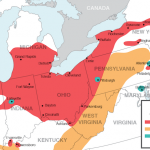
He’s trailing, however, in Ohio and Iowa, which means they probably become winnable only in the midst of a big Biden victory. He has a decent cushion as well in Michigan (6.6 percent) and Minnesota (6.2 percent), and a slimmer one in Pennsylvania (4.1 percent). In the competitive Rust Belt states, Biden’s national lead is matched only by his advantage in Wisconsin (7.5 percent).

Of the realistic Sun Belt targets for Democrats, Biden has a robust lead only in Nevada (6.4 percent), which Democrats carried in 2016, and Arizona (4.7 percent).

Again using FiveThirtyEight’s polling averages, Biden’s currently trailing in Georgia and Texas, and has a lead under 2 percent in Florida and North Carolina. If Biden maintains that sort of lead through Election Day, then the Electoral College will take care of itself and the Democrat will win very comfortably across the range of battleground states in both competitive parts of the country.īut if the national race tightens, the battleground situation gets much more complicated. According to FiveThirtyEight’s polling averages, Joe Biden leads Donald Trump nationally by 7.5 percent. So here we are less than two months away from Election Day, and with early voting beginning almost immediately, and the best strategic path is still unclear. In the end, the Democratic presidential strategy for ejecting Trump in 2020 will follow the polls - hopefully better and more frequent polls than those taken by the Clinton campaign in those heartland states that ultimately cost them the election of 2016 - and perceived opportunities. I concluded the midterm numbers didn’t really indicate one path or the other, and that 2020 polling data might dictate the best strategy for both parties: There are two similar additional states that Obama carried twice: Iowa and Ohio.Īt the other end of the spectrum are Sun Belt states that were already quite close (Florida and North Carolina) or that have recently been trending Democratic (Arizona, Georgia, and Texas) at varying rates. The two most obvious regional strategies for Democrats are to win back the heartland/Rust Belt (depending on how you think about them) states that Trump narrowly carried despite a strong history of going the other way: Michigan, Pennsylvania and Wisconsin. Soon after the 2018 midterms, I reviewed the evidence about where Democrats made gains and suggested it still wasn’t clear which strategy the party should adopt in trying to recover from the 2016 loss to Trump:


 0 kommentar(er)
0 kommentar(er)
